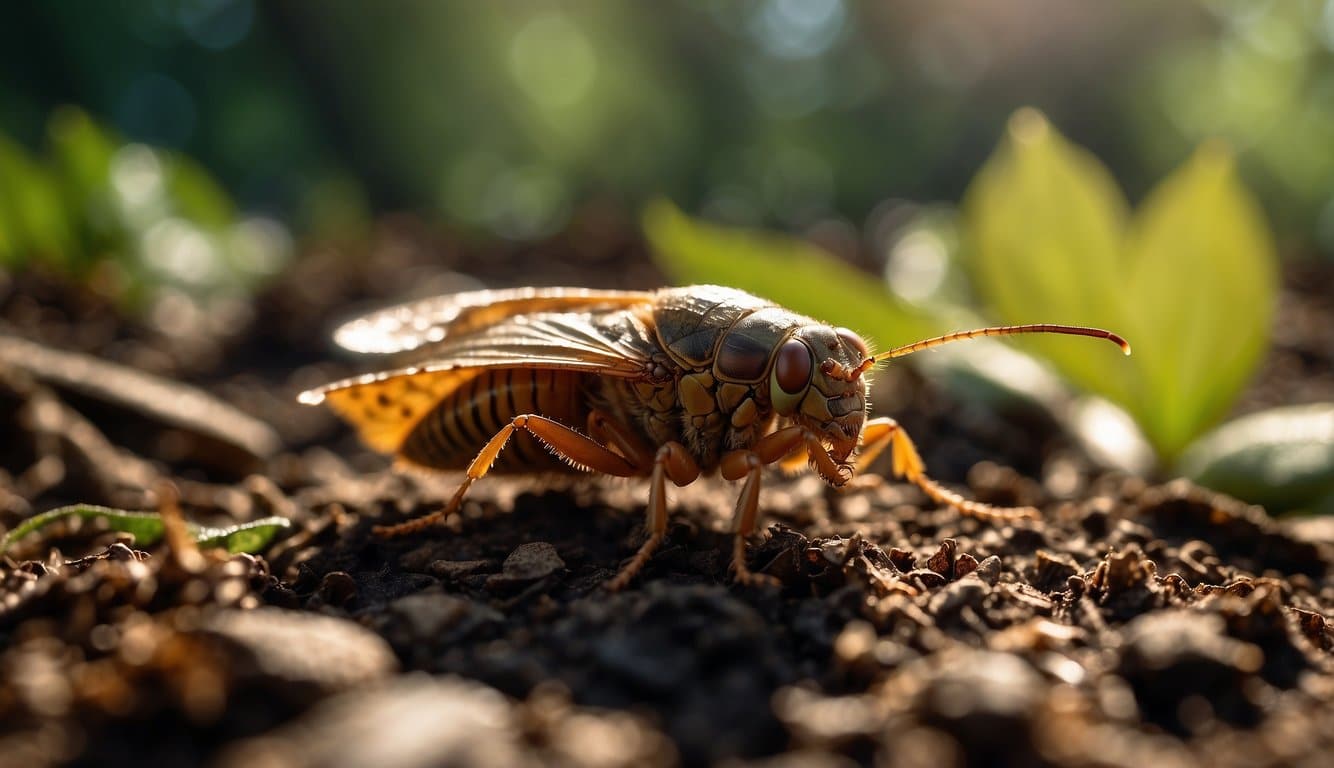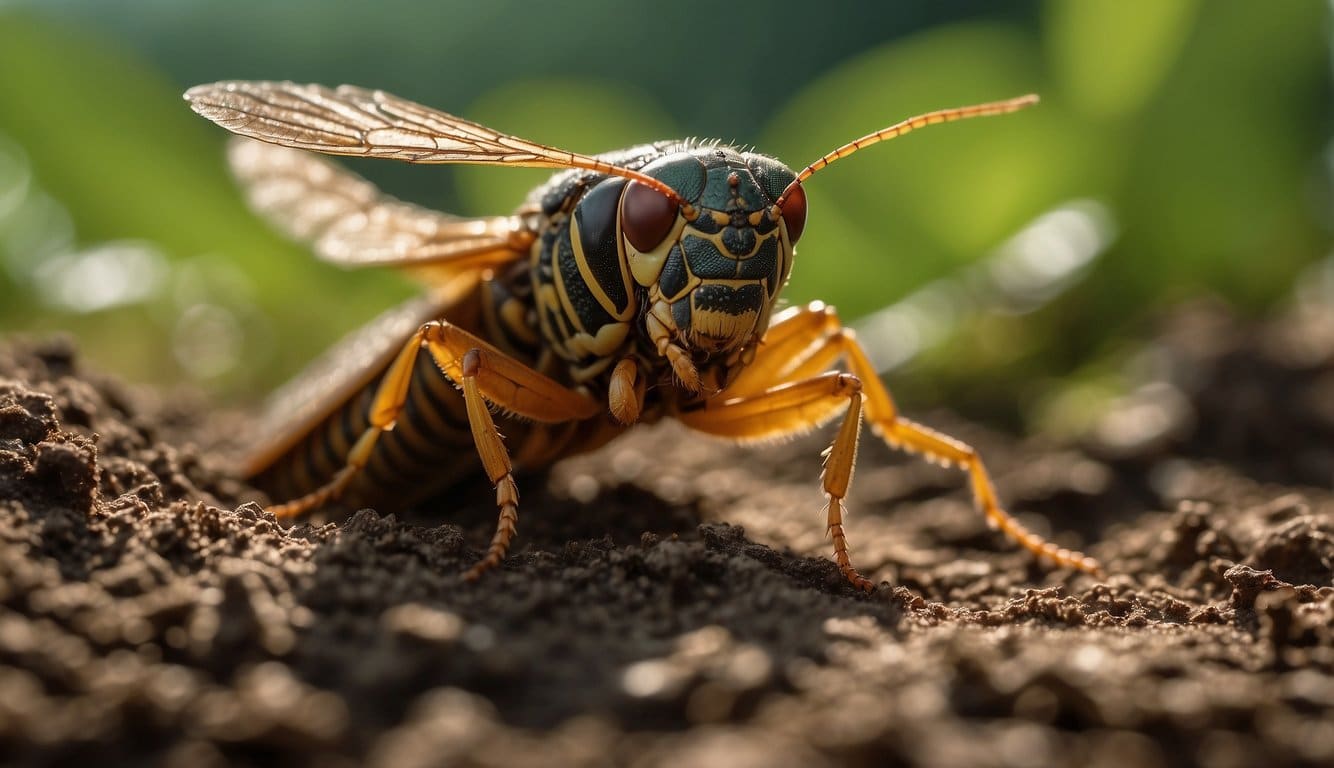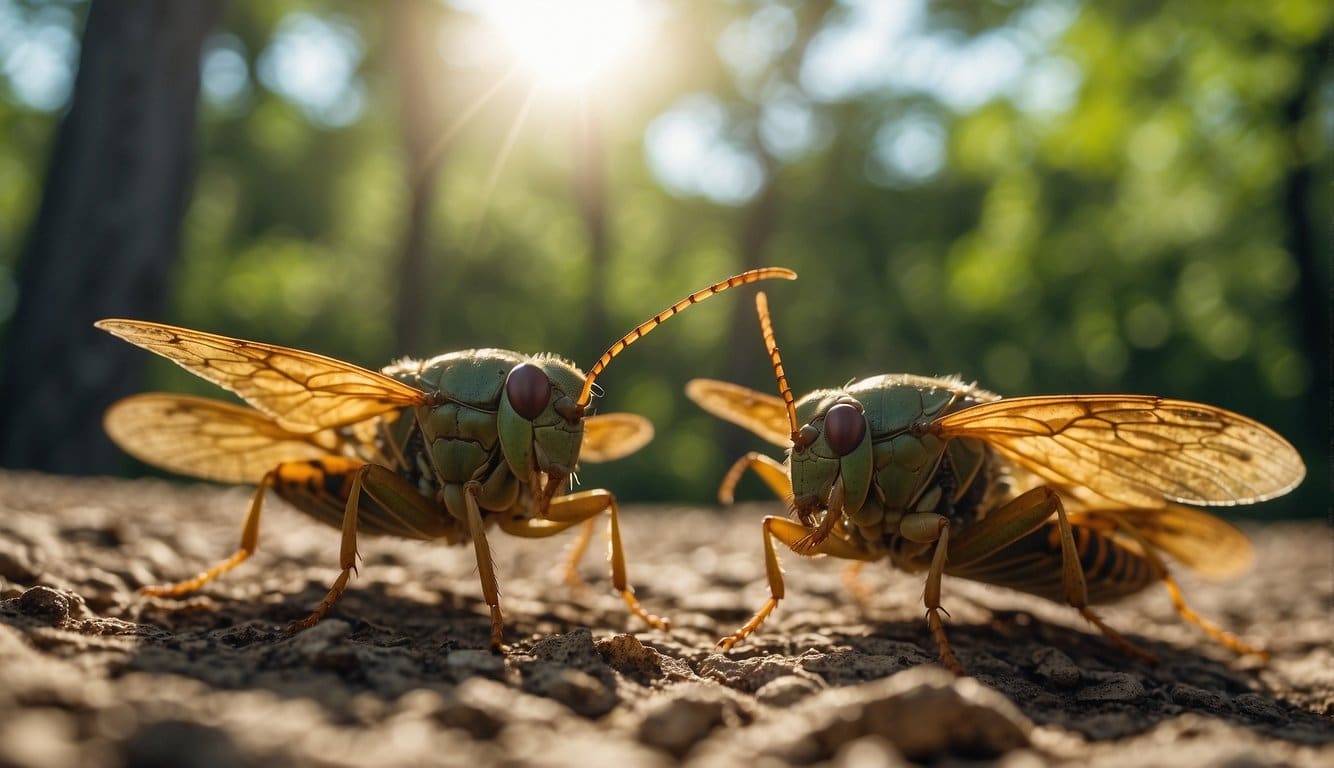Cicada Emergence Cycle
Before you set out on your next outdoor adventure, you might want to check if you’ll be joined by the fascinating symphony of cicadas.
These insects have a unique life cycle, with some appearing annually and others making a grand entrance every 13 or 17 years.
Periodical Cicadas
Key Features:
- Broods: Distinct groups emerging
- Emergence Schedule: Every 13 or 17 years
Periodical cicadas are like nature’s timekeepers, reappearing after 13 or 17 years underground.
Your calendar for these winged wonders depends on their specific brood:
- 13-Year Cicadas: Most often found in the southern and midwestern United States.
- 17-Year Cicadas: Typically emerge in the northern states.
In 2024, expect to witness the spectacular emergence of periodical cicadas, where different broods may synchronize in an impressive display.
Annual Cicadas
What to Expect:
- Frequency: Every year
- Soundtrack: Late-summer buzz
Unlike their periodical cousins, annual cicadas grace us with their presence every year. Here’s what you’ll find:
- Appearance Period: Usually from late June through August.
- Geographic Range: Across the United States.
Across the country, you can hear the familiar buzz of annual cicadas, filling the summer air with their song.
Factors Influencing Cicada Emergence

When you’re eagerly waiting to witness the spectacular event of cicada emergence, there’s a myriad of factors playing behind the curtains.
To catch the symphony of their arrival, you need to tune into the following:
- Biological Clocks: Cicadas have internal timers coordinating their emergence. This clockwork is so precise that certain broods, like the 17-year cicadas, spend almost two decades underground.
- Soil Temperature: The thermometer for cicadas is the soil temperature. They’re likely to make their grand entrance once the soil comfortably reaches approximately 64 degrees Fahrenheit (18°C).
- Geographical Broods: You may spot cicadas depending on your stomping grounds. Specific broods cover certain geographies, with the Eastern United States being a prime locale for these critters.
Here’s a quick checklist to keep your eyes on the prize:
- Check the calendar: Mark years that are prime for cicada emergence.
- Monitor the soil: Keep a casual soil thermometer handy.
- Track cicada broods: Stay updated with reports such as the cicada emergence guide.
And when you hear that unmistakable buzz, congratulate yourself—you’ve just caught the pulse of one of nature’s most clockwork phenomena! 🌿🎶
Regional Variations in Cicada Populations
Cicadas are a fascinating part of nature’s symphony, especially when you consider their mind-boggling life cycles and regional differences! Here’s the buzz on how these critters vary across the map:
- Frequency of Emergence: You’ve probably heard about the famous 17-year cicadas, part of Brood XIII, often center stage in Northern Illinois. But wait—there’s more! Some of your chirping pals emerge every 13 years as well, forming an enthralling pattern across different regions. Check out these rhythmic bugs periodically surfacing in billions.
- Brood Synchronicity: Imagine a duo of different-age broods throwing a joint backyard party. That’s what’s happening with cicadas in some areas. A 13-year and a 17-year brood might rarely overlap, making for an epic biological bash that occurs just once every couple of centuries—talk about exclusive invites! Dive into this rare occurrence with these maps and timelines.
- Where to Witness: Feeling adventurous? You might catch this rare event in specific locales like Illinois and Iowa, with several other states getting in on the action. Cicadas are not shy about their comeback tours, so for the front-row experience, here’s where to scope them out: see the cicada emergence maps.
Remember, your cicada pals spend most of their lives underground, so when they do decide to join the surface world, it’s definitely something to write home about. Each emergence is a unique concert depending on your zip code, so grab your map and enjoy nature’s show!
Implications of Cicada Emergence Patterns
Cicada emergences aren’t just a fascinating natural event; they carry significant implications for various aspects of the environment. When these insects make their grand entrance, they do so in large numbers, and this has several effects:
- Ecological Impact: Cicadas become a major food source for predators. Your local birds, raccoons, and even pets may feast on these insects, potentially having a boom in their populations as a result.
- Tree Life Cycle: You might notice many tiny holes around your trees. These are cicada egg nests. While a large number of cicadas can cause visual damage to young trees, this is rarely fatal and is a natural part of the ecosystem.
- Soundscapes: Brace your ears! Cicadas bring a unique cacophony that can reach up to 100 decibels. Outdoors activities? You’ll partake in nature’s own symphony.
- Soil Aeration: When the nymphs emerge, they create numerous tunnels in the ground, inadvertently aerating the soil, which can benefit your garden.
Consider these tips when you’re in the path of a cicada emergence:
- Protection for young trees – Consider netting to prevent cicadas from causing excessive harm.
- Embrace the cycle – Your patience will be rewarded as cicadas don’t stay long and are harmless to humans.
- Record the phenomenon – This periodic event is a spectacle worth documenting, whether you’re into photography or nature journaling.
Remember, these are periodical cicadas that emerge as part of a 13 or 17-year lifecycle. So when you see them, consider yourself part of a rare natural timeline!
Frequently Asked Questions
Cicadas fascinate with their unique lifecycle, spending most of their existence underground only to emerge en masse. Dive into the details about these periodic insects with the questions you’re buzzing to ask.
What triggers the emergence of cicadas from underground?
You might be surprised at how precisely timed the appearance of cicadas is.
It’s all about the soil temperature reaching about 64 degrees Fahrenheit, at which point you’ll see these insects start to come up from their subterranean lair.
Can cicadas be spotted in cycles other than the well-known 13 or 17 years?
Yes, there are indeed 12 broods of 17-year cicadas and 3 broods of 13-year cicadas, but cicadas from different broods might make unexpected appearances off-schedule, usually influenced by environmental factors.
Are there particular environmental conditions that dictate the exact timing of a cicada appearance?
Certainly!
Aside from the crucial soil temperature, other environmental aspects like climate, the depth at which they were buried, and regional weather patterns play roles in exactly when you’ll encounter these periodic critters.
What differentiates periodic cicada broods from each other?
Broods are primarily differentiated by their 17-year or 13-year cycles. Each brood is also assigned a Roman numeral to track its emergence year and geographic location across the United States.
In what ways does the cicada’s life cycle differ from that of locusts?
While they’re often confused with locids, cicadas have a completely different life cycle.
They spend their formative years underground unlike locusts, which have shorter life cycles and can form swarms seasonally. Cicadas also don’t swarm in the same destructive manner that locusts are known for.
What are the behaviors and patterns of cicadas during their above-ground lifespan?
Once above ground, cicadas live life to the fullest for about four to six weeks.
During this time, their behaviors and patterns are all about molting, singing (in the case of males), mating, and laying eggs.
Then, their life cycle begins anew as the next generation burrows underground.

